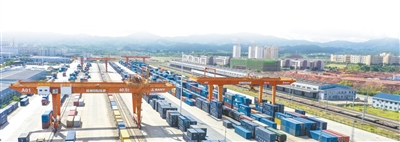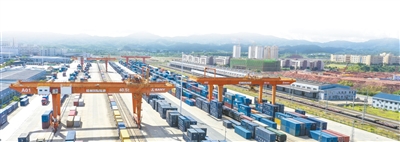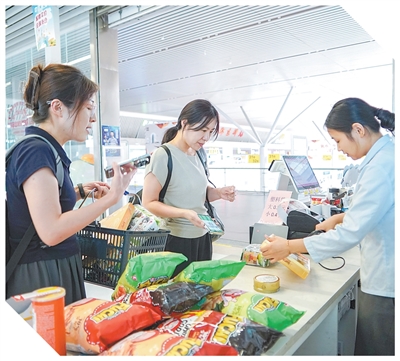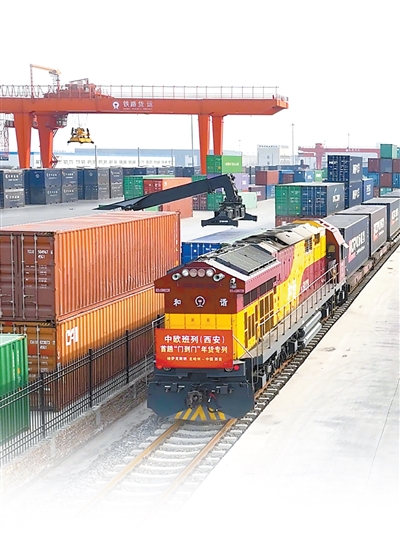




- BRNN
- BRI News
- BRNN News
- Database
Official Documents Polices and Regulations
Inter-government Documents International Cooperation BRI Countries
Business Guide Economic Data BRI Data
Trade
Investment Projects Latest projects
Cases - Content Pool

A China-Europe freight train loaded with sawn timber and other products from Belarus enters China via the Erenhot land port in north China's Inner Mongolia Autonomous Region. (Photo/Yu Hao)
The China-Europe freight trains have made 110,000 trips, including return journeys. Together, these trains have transported goods worth over $450 billion. For 62 straight months, more than 1,000 trains have run each month.
What products have China-Europe freight trains brought back to China, and what opportunities have they created for countries along the route?
Convenient freight train service enables faster and more efficient furniture manufacturing
The China-Europe freight train service has injected momentum into a thriving furniture industry with an output value of 280 billion yuan (about $39.02 billion) in Nankang district, Ganzhou city, east China's Jiangxi Province.
In the Ganzhou International Inland Port, a train loaded with European spruce and European silver fir entered the station. According to a person in charge of railway logistics at the China Railway Nanchang Group, in the past, it took three months for a cubic meter of timber to arrive from Russia, and the cost was as high as 4,000 yuan.
Thanks to the China-Europe freight train service, the timber import time has been reduced to 14 days. The person said that by innovating the transportation model, the return trip of the trains has been reduced to 12 days, which is 25 days shorter than traditional sea transport, with an 18 percent reduction in comprehensive logistics costs.

Loading operations are underway in the Ganzhou International Inland Port in Ganzhou city, east China's Jiangxi Province. (Photo/Zou Yang)
Nankang is the largest solid wood furniture production base in the country. Thanks to the model which integrates the port, the bonded zone, and cross-border services at the Ganzhou International Inland Port, furniture from Nankang has been exported to countries and regions such as Europe, the U.S., Southeast Asia, Central Asia and the Middle East, with overseas orders amounting to over 5 billion yuan.
The port has operated more than 1,600 China-Europe freight train trips, covering five Central Asian countries and more than 100 cities in over 20 countries in Europe.
China-Europe freight trains bring more premium products from the globe to local residents
Covering an area of more than 1,000 square meters and located on the second floor of the waiting hall of Zhengzhou East Railway Station in Zhengzhou, central China's Henan Province, a supermarket offering imported goods transported by China-Europe freight trains is packed with tourists.
Eleven China-Europe freight train routes originating from and terminating at Zhengzhou are now operating on a regular basis, with an overseas freight collection and distribution network reaching over 30 countries and 130 cities. The service, with more than 6,000 partners at home and abroad, transports over 1,000 types of imported and exported goods.

Passengers shop at a supermarket offering imported goods transported by the China-Europe freight train service at Zhengzhou East Railway Station in Zhengzhou, central China's Henan Province. (Photo/Cui Xuanhao)
"We've actively adapted to market demand by launching supermarkets selling imported daily necessities, so more people can benefit from the high-quality operation of China-Europe freight trains," said Han Wei, chairman of Henan Zhongyuan Railway Tourism Group Co., Ltd.
Han said supermarkets offering products transported to the city via the China-Europe freight train service are located at eight high-speed railway stations in the province, as well as many local residential communities.
Flour from Kazakhstan offers a taste of Silk Road in Xi'an
At the lifestyle experience center of Xi'an Aiju Grain and Oil Industrial Group in Xi'an Chanba International Port in Xi'an, northwest China's Shaanxi Province, visitors watch a cook making oil-splashed noodles. The flour used to make the noodles was imported from Kazakhstan and transported to the city via China-Europe freight trains.
On March 26, 2016, the first returning China-Europe freight train carrying 2,000 tonnes of edible oil from Kazakhstan arrived at the railway freight yard in Xi'an Chanba International Port. The oil was imported by Aiju. Leveraging the China-Europe freight train service, Aiju embarked on a journey of investing in crop farming and opening processing factories in Kazakhstan.
Over the past years, the company has developed contract farming in the North Kazakhstan Region, initially promoting the cultivation of raw materials across 1.5 million mu of farmland (100,000 hectares).
"Last year, we opened several processing plants in the North Kazakhstan Region to produce flour, noodles, and animal feed. With increased output from our overseas facilities, more goods are now being shipped back to China," said Liu Dongmeng, secretary of the Party committee at Aiju.
Aiju now operates a grain and oil sales network with around 1,000 outlets. By the end of June this year, it had imported 400,000 tonnes of agricultural products, such as wheat, flour, and edible oil, from Kazakhstan.
Faster logistics enable efficient car imports in Chongqing
At dawn on June 18, containers loaded with cars made in Germany stood ready at the Tuanjiecun Station in the Chongqing International Logistics Hub Park in southwest China's Chongqing Municipality. After customs clearance, inspection, and registration, the cars would be sent to 4S dealerships across western China.
"This batch left Germany on June 2, passing through Poland, Russia, and Kazakhstan, and entered China via Alashankou land port—over 10,000 kilometers in just 16 days," said Tan Renyun, business manager at Yuxinou (Chongqing) Logistics Co., Ltd.

The first China-Europe freight train loaded with New Year goods arrives in Xi'an, northwest China's Shaanxi Province. (Photo/Sun Jixiang)
Since Chongqing started to import cars via the China-Europe freight train service in 2014, more than 40,000 vehicles from Europe have entered the city by rail and distributed across more than 10 provinces in southwest and northwest China.
"Previously, car imports relied on sea freight—35 days from Hamburg via the Suez Canal to Shanghai, then by road to Chongqing," said Tan, who added that rail is slightly more expensive, but cuts delivery time to around 16 days.
"Thanks to China-Europe freight trains, we can bring in the latest models faster. We're planning a regional distribution center in Chongqing to improve service further," said a car dealer.
In 2024, return shipments to Chongqing via China-Europe freight trains reached $1.6 billion, with cars, electronics, and machinery accounting for over 45 percent.

Tel:86-10-65363107, 86-10-65368220, 86-10-65363106